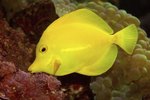The general rule of thumb, when stocking any aquarium, is to allow one gallon of water for each inch of fish. Therefore, in a 30 gallon tank you have enough room for 30 inches of fish. For example, you have enough room in your 30 gallon tank if you stock it with 15 two-inch neon tetras. Be sure that when calculating the number of fish in your tank that you allow for the full-grown expected size of each fish. Typically, younger fish are sold at fish stores and their size can be deceiving, so do your research first.
Saltwater or Freshwater
First, you need to decide if you want to have a saltwater or freshwater tank. For a 30-gallon tank, it is advisable to stock it with freshwater fish. This is an easier environment to start up and maintain, not to mention it’s a lot cheaper.
Types of Fish
It is important to research what kinds of fish you want for your tank if they are expected to all get along. Pay attention to the types of fish you have. If you want a schooling fish, make sure you get more than one, etc. Also pay attention to the size of your fish. Generally, if a larger fish can eat one of the smaller ones, it will.
Some tips: In a tank with goldfish, it is advisable to keep only goldfish. Cichlids are very aggressive and should only be kept with other cichlids. Angelfish, though beautiful, are also incredibly aggressive and should not be kept with other angelfish.
Setting Up Tank
When you are setting up your tank, make sure to have plenty of hiding places for your fish (plants, rock formations, etc.). By doing so, you will cut down on the stress level in the tank. When your tank is all set up, it is also important for you to run the filter for at least 24 hours to stabilize the water.
Stocking
When you decide what you want to stock your tank with, be sure not to overstock. When adding new fish to the environment make sure that they have had a chance to acclimate to the temperature of your tank. Float the bag from the pet store in the tank for an hour or so. When making the transfer of the fish into the tank, do not pour any of the water from the pet store bag into your tank. It is very important to make sure that the water stays as stable as possible.
Troubleshooting
If the new additions you have made to your fish tank don't take to their new environment, there are a few things that you can check:
Keep a log of when you added which fish into the tank. This will be a good record to know which type of fish purchased from particular stores were a good addition or a bad one.
Purchase a kit to test the chemical levels in the water.
Sometimes the move from one tank to another is too stressful for a fish. White spots can appear on the scales of the fish. This is known as ich. Remove the fish as quickly as possible so that it does not infect the rest of the tank.
Writer Bio
Sara Gerou is a freelance writer living in Chicago. She received her Bachelor of Arts in English and fine arts and also holds an Master of Fine Arts in creative writing. With three years of professional writing and editing experience, Gerou has been published in McGraw-Hill's "Colorado Construction Magazine," Denver Syntax and Examiner.com.





